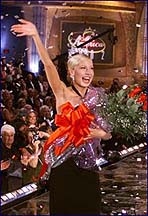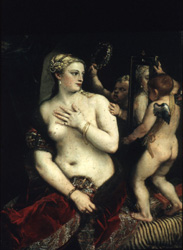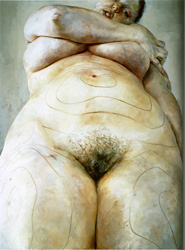The Social Construction of Gender
"Men look at women. Women watch themselves being looked at." -John Berger
Velazquez, The Rokeby Venus
"Vanity-Sitting pretty! Get yourself ready for a special day...." -Just Kids catalog, 1994.
The Social Construction of Gender
"Men look at women. Women watch themselves being looked at." -John Berger
Velazquez, The Rokeby Venus
"Vanity-Sitting pretty! Get yourself ready for a special day...." -Just Kids catalog, 1994.
To be born a man or a woman in any society is more than a simple biological fact. It is a biological fact with social implications. Women constitute a distinct social group, and the character of that group, long neglected by historians, has nothing to do with feminine "nature." "Gender" is the term now widely used to refer to those ways in which a culture reformulates what begins as a fact of nature. The biological sexes are redefined, represented, valued, and channeled into different roles in various culturally dependent ways. An American anthropologist has put it well: a "Sex/gender system [is] a set of arrangements by which a society transforms biological sexuality in to products of human activity, and in which there transformed sexual needs are met."
"Woman" is a creation of the masculine gaze. Before we can see how women thought of themselves and of their relations with men, we must find out how they were seen by men. The masculine conception of woman gave rise to idealizations and norms that strongly influenced the behavior of women, who lacked the power to challenge the male view of their sex.
Rubens, The Judgement of Paris, c. 1638.

Miss America 2002: Katie Harman
Laura Mulvey, "Visual Pleasure and Narrative Cinema," in Visual and Other Pleasures, p.19: In a world ordered by sexual imbalance, pleasure in looking has been split between active/male and passive/female. The determining male gaze projects its fantasy onto the female figure, which is style accordingly. In their traditional exhibitionist role women are simultaneously looked at and displayed, with their appearance coded for strong visual and erotic impact so that they can be said to connote to-be-looked-at-ness....
/p. 20: An active/passive heterosexual division of labour has similarly controlled narrative structure. According to the principles of the ruling ideology and the psychical structures that back it up, the male figure cannot bear the burden of sexual objectification. Man is reluctant to gaze at his exhibitionist like. Hence the split between spectacle and narrative supports the man's role as the active one of advancing the story, making things happen. The man controls the film fantasy and also emerges as the representative of power in a further sense: as the bearer of the look of the spectator, transferring it behind the screen to neutralise the extradiegetic tendencies represented by woman as spectacle....As the spectator identifies with the main male protagonist, he projects his look onto that of his like, his screen surrogate, so that the power of the male protagonist as he controls events coincides with the active power of the erotic look.
Excerpts from John Berger, Ways of Seeing
p.46: To be born a woman has to be born, within an allotted
and confined space, into the keeping of men. The social presence of women is
developed as a result of their ingenuity in living under such tutelage within
such a limited space. But this has been at the cost of a woman's self being
split into two. A woman must continually watch herself. She is almost continually
accompanied by her own image of herself. Whilst she is walking across a room
or whilst she is weeping at the death of her father, she can scarcely avoid
envisaging herself walking or weeping. From earliest childhood she has been
taught and persuaded to survey herself continually.
And so she comes to consider the surveyor and the surveyed within her as the two constituent yet always distinct elements of her identity as a woman. She has to survey everything she is and everything she does because how she appears to men, is of crucial importance for what is normally thought of as the success of her life. Her own sense of being in herself is supplanted by a sense of being appreciated as herself by another....
p. 47: One might simplify this by saying: men act and women appear.
Men look at women.  Women
watch themselves being looked at.
Women
watch themselves being looked at.  This
determines not only most relations between men and women but also the relation
of women to themselves. The surveyor of woman in herself is male: the surveyed
female. Thus she turns herself into an object -- and most particularly an object
of vision: a sight.
This
determines not only most relations between men and women but also the relation
of women to themselves. The surveyor of woman in herself is male: the surveyed
female. Thus she turns herself into an object -- and most particularly an object
of vision: a sight.
Tintoretto, Susanna and the Elders, 1555-56.
Consider the play of mirrored images in Mary Cassatt's Mother and Child of 1908:
Like the mirror
in the paintings of Titian and Rubens above, what the young girl sees in the
mirror is not her own reflected image, but that of the viewer looking at her.
She is thus looking at herself being looked at.  An interesting detail is the prominent sunflower on the mother's dress. The sunflower was a motif employed by Anthony Van Dyck in a self-portrait. In this context the sunflower signified van Dyck's function as a court painter. Like the sunflower seeks the sun, so does the court painter seek the favor of his patron. In the context of the domestic world of the early twentieth century, the sunflower would follow the patriarch of the family. As the observer of the painting we become the husband/father. I am struck by the similarities
of the reflected image of the woman in the mirror in the upper left corner of
the painting to Fragonard's painting of a Young Girl Reading:
An interesting detail is the prominent sunflower on the mother's dress. The sunflower was a motif employed by Anthony Van Dyck in a self-portrait. In this context the sunflower signified van Dyck's function as a court painter. Like the sunflower seeks the sun, so does the court painter seek the favor of his patron. In the context of the domestic world of the early twentieth century, the sunflower would follow the patriarch of the family. As the observer of the painting we become the husband/father. I am struck by the similarities
of the reflected image of the woman in the mirror in the upper left corner of
the painting to Fragonard's painting of a Young Girl Reading:
The mirror in the painting does not reflect the woman accurately as she would be seen from that perspective, but considering the parallel to the Fragonard painting, isn't the mirror reflecting the woman as she would be imaged in painting? Like the young girl in Fragonard's painting, the reflected image of the woman is a profile rather than the lost profile that would actually been seen in the mirror from this perspective. The mirrored image thus acts like painting in purifying vision.
Excerpts from Sandra Lee Bartky, "Foucault, Femininity, and the Modernization of Patriarchal Power,"in Feminism and Foucault, Irene Diamond & Lee Quinby eds., 61-86.
p. 64: We are born male or female, but not masculine or
feminine. Femininity is an artifice, an achievement, 'a mode of enacting and
reenacting received gender norms, which surface as so many styles of the flesh."
In what follows, I shall examine those disciplinary practices that produce a
body which in gesture and appearance is recognizably feminine. I consider three
categories of such practice: those that aim to produce a body of certain size
and general configuration; those that bring forth from this body a specific
repertoire of gestures, postures, and movements; and those that are directed
toward the display of this body as an ornamented surface. I shall examine the
nature of these disciplines, how they are imposed and by whom. I shall probe
the effects of the imposition of such discipline on female identity and subjectivity.
In the final section I shall argue that these disciplinary practices must be
understood in the light of the modernization of patriarchal domination, a modernization
that unfolds historically....
Styles of the female figure vary over time and across
cultures: they reflect cultural obsessions and preoccupations in ways that are
still poorly understood.  Today,
massiveness, power, or abundance in a woman's body is met with distaste.
Today,
massiveness, power, or abundance in a woman's body is met with distaste.  The
current body of fashion is taut, small-breasted, narrow-hipped, and of a slimness
bordering on emaciation; it is a silhouette that seems more appropriate to an
adolescent boy or a newly pubescent girl than to an adult woman. Since ordinary
women have normally quite different dimensions, they must of course diet.
The
current body of fashion is taut, small-breasted, narrow-hipped, and of a slimness
bordering on emaciation; it is a silhouette that seems more appropriate to an
adolescent boy or a newly pubescent girl than to an adult woman. Since ordinary
women have normally quite different dimensions, they must of course diet.
Mass-circulation women's magazines run articles on dieting
in virtually every issue. The Ladies' Home Journal of February 1986 carries
a "Fat Burning Exercise Guide," while Mademoiselle offers to
"Help Stamp Out Cellulite" with "Six Sleek-Down Strategies."
After the diet-busting Christmas holidays and, later, before summer bikini season,
the titles of these features become shriller and more arresting. The reader
is now addressed in the imperative mode: Jump into shape for summer! Shed ugly
winter fat with the all-new Grapefruit Diet...!
Dieting disciplines the body's hungers: appetite must be monitored at all times and governed by iron will. Since the innocent need of the organism for food will not be denied, the body becomes one's enemy, an alien being bent on thwarting the disciplinary project....
p. 66: There are significant differences in gesture, posture,
movement, and general bodily comportment: women are far more restricted than
men in their manner of movement and in their spatiality. In her classic paper
on the subject, Iris Young observes that a space seems to surround women in
imagination that they are hesitant to move beyond: this manifests itself both
in a reluctance to reach, stretch, and extend the body to meet resistances of
matter in motion --as in sport or in the performance of physical tasks-- and
in a typically constricted posture and general style of movement. Woman's space
is not a field in which her bodily intentionality can be freely realized but
an enclosure in which she feels herself positioned and by which she is confined.
The "loose woman" violates these norms: her looseness is manifest
not only in her morals, but in her manner of speech and quite literally in the
free and easy way she moves.
In an extraodinary series of two thousand photographs, many (p. 67) candid shots
taken in the street, the German photographer Marianne Wex has documented differences
in typical masculine and feminine body posture. Women sit waiting for trains
with arms close to the body, hands folded together in their laps, toes pointing
straight ahead or turned inward, and legs pressed together. The women in these
photographs make themselves small and narrow, harmless; they seem tense; they
take up little space. Men, on the other hand, expand into the available space;
they sit with legs far apart and arms flung out at some distance from the body....
But women's movement is subjected to a still finer discipline.
Feminine faces, as well as bodies, are trained to the expression of deference.
Under male scrutiny, women will avert their eyes or cast them downward; the
female gaze is trained to abandon its claim to the sovereign status of seer.
The 'nice' girl learns to avoid the bold unfettered staring of the 'loose' woman
who looks at whatever and whomever she pleases. Women are trained to smile more
than men, too....
Feminine movement, gesture, and posture must exhibit not only constriction, but grace and a certain eroticism restrained by modesty: all (p.68) three. Here is field for the operation for a whole new training: a woman must stand with stomach pulled in, shoulders thrown slightly back and chest out, this to display her bosom to maximum advantage. While she must walk in the confined fashion appropriate to women, her movements must, at the same time, be combined with a subtle but provocative hip-roll. But too much display is taboo....
[A] woman's body is an ornamented surface too, and there
is much discipline involved in this production as well. Here, especially in
the application of makeup and the selection of clothes, art and discipline converge....
A woman's skin must be soft, supple, hairless, and smooth; ideally, it should betray no sign of wear, experience, age, or deep thought. Hair must be removed not only from the face but from large surfaces of the body as well....
p. 71: Are we dealing in all this merely with sexual difference ? Scarcely. The disciplinary practices I have described are part of the process by which the ideal body of femininity --and hence the feminine body-subject-- is constructed; in doing this, they produce a 'practice and subjected; body, that is, a body on which an inferior status has been inscribed. A woman's face must be made-up, that is to say, made-over, and so must her body; she is ten pounds overweight; her lips must be made more kissable, her complexion dewier, her eyes more mysterious. The 'art' of makeup is the art of disguise, but this presupposes that a woman's face, unpainted, is defective.... The technologies of femininity are taken up and practices by women against the background of a pervasive sense of bodily deficiency: this accounts for what is often their compulsive or even ritualistic character....
p. 72: In the regime of institutionalized heterosexuality, woman must make herself "object and prey" for the man: it is for him that these eyes are limpid pools, this cheek baby-smooth. In contemporary patriarchal culture, a panoptical male connoisseur resides within the consciousness of most women: they stand perpetually before his gaze and under his judgement. Woman lives her body as seen by another, by an anonymous patriarchal Other.
See the article by Nancy Henley and Jo Freeman, "The Sexual Politics of Interpersonal Behavior."

Albrecht Dürer, Draughtsman Drawing a Nude
When asked to visualize the subject of an artist representing a nude, what is your expectation?
Excerpts from Rosalind Coward, Female Desires
p.75: [The] preoccupation with
visual images strikes at women in a very particular way. For looking is not
a neutral activity. Human beings don't all look at things in the same way, innocently
as it were. In this culture, the look is largely controlled by men. Privileged
in general in this society, men also control the visual media. The film and
television industries are dominated by men, as is the advertising industry.
The photographic profession is no less a bastion of the values of male professionalism.
While I don't wish to suggest there's an intrinsically male way of making images,
there can be little doubt that entertainment as we know it is crucially predicted
on a masculine investigation of women, and a circulation of women's images for
men.
The camera in contemporary media has been put to use as
an extension of the male gaze at women on the streets. Here, men can and do
stare at women; men assess, judge and make advances on the basis of these visual
impressions. The ability to scrutinize is premised on power. Indeed the look
confers power; women's inability to return such a critical and aggressive look
is sign of subordination, of being recipients of another's assessment. Women,
in the flesh, often feel embarrassed, irritated or downright (/p. 76) angered
by men's persistent gaze. But not wanting to risk male attention turning to
male aggression, women avert their eyes and hurry on their way. Those women
on the billboards, though; they look back. Those fantasy women stare off the
walls with a look of urgent availability.
p.81: Where women's behaviour was previously controlled directly by state, family or church, control of women is now also effected through the scrutiny of women by visual ideals. Photography, film (/p.82) and television offer themselves as transparent recordings of reality. But it is in these media where the definitions are tightest, where the female body is most carefully scripted with the prevailing ideals. Women internalize the damage created by these media; it is the damage of being the differentiated and therefore the defined sex. Women become the sex, the sex differentiated from the norm which is masculine. Women are the sex which is constantly questioned, explained, defined. And as the defined sex, women are put to work by the images. The command created by an image-obsessed culture is 'Do some work! Transform Yourself! Look Better! Be more erotic!' And through this command to meet the ideal, our society writes one message loud and clear across the female body. Do not act. Do not desire. Wait for men's attention.
After all these images of women looking at their images in mirror, consider the one myth with the male looking at his own reflection: Narcissus as exemplified in this painting by Caravaggio:
Narcissus: Greek Mythology: A youth who, having spurned the love of Echo, pined away in love of his own image in a pool of water and was transformed into a flower which bears his name.
Narcissism- sexual excitement through admiration of oneself. self-love; erotic gratification derived from admiration of one's own physical or mental attributes.
On the basis of the preceding discussions, compare the following two images:
Velazquez, The Rokeby Venus
Sylvia Sleigh, Philip Golub Reclining, 1971.